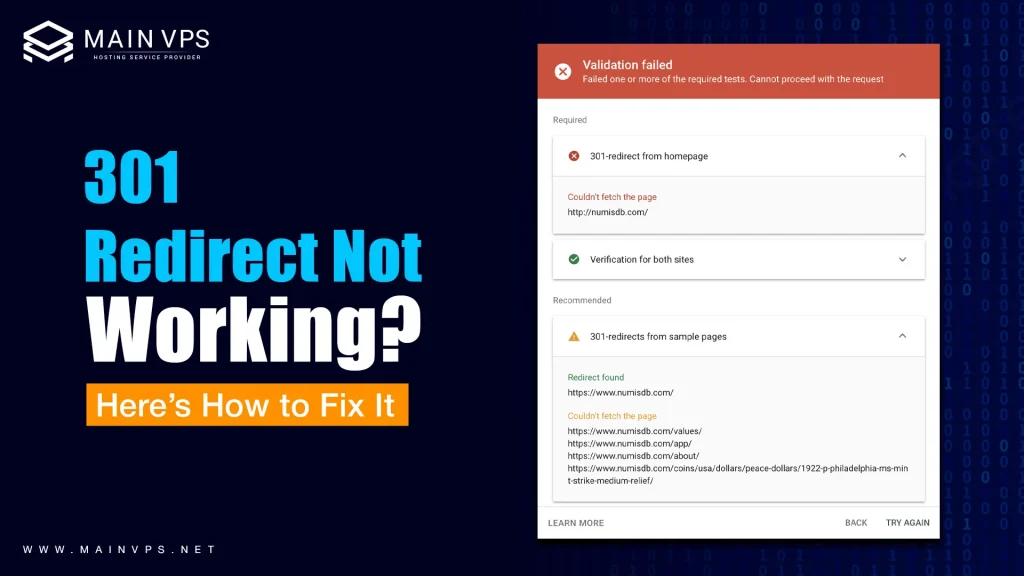
Few things are more frustrating than setting up a 301 redirect—only to find it doesn’t work. Whether you’re migrating a site, restructuring URLs, or fixing broken links, a failed redirect can hurt SEO, break user experience, and waste traffic.
In this guide, you’ll learn:
✅ Why 301 redirects fail (and how to fix them)
✅ Common mistakes in .htaccess, WordPress, and server configs
✅ How to test redirects properly
✅ Best practices to avoid future issues
What Is a 301 Redirect & Why Does It Matter?
A 301 redirect is a permanent URL redirect that tells search engines and browsers:
🔹 “This page has moved permanently—send traffic to the new location.”
Why It’s Critical for SEO & UX
✔ Preserves SEO rankings (passes ~90% of link equity)
✔ Prevents 404 errors (users land on the right page)
✔ Maintains backlink value (avoids broken links)
But when 301 redirects fail, you risk:
❌ Lost rankings (Google drops the old URL)
❌ Broken user journeys (visitors hit dead ends)
❌ Wasted crawl budget (search engines waste time on dead pages)
7 Reasons Why 301 Redirects Fail (And How to Fix Them)
1️⃣ Incorrect Syntax in .htaccess or Server Config
Problem: A tiny typo can break everything.
Common mistakes:
- Missing
http://orhttps:// - Wrong path (
/old-pagevs./old-page/) - Using
Redirectinstead ofRedirectMatch
✅ Fix:
apache
# Correct .htaccess syntax (Apache) Redirect 301 /old-page https://example.com/new-page # For regex matching: RedirectMatch 301 ^/old-path/(.*)$ https://example.com/new-path/$1
Check:
- Test in incognito mode (bypasses cache)
- Use
curl -I http://example.com/old-pageto verify HTTP status
2️⃣ Browser or CDN Caching Issues
Problem: Your redirect works—but you can’t see it because of caching.
✅ Fix:
✔ Clear browser cache (or use incognito)
✔ Purge CDN cache (Cloudflare, Varnish, etc.)
✔ Restart web server (if using Nginx/Apache)
Pro Tip:
Use curl or Redirect Checker tools to bypass local caching.
3️⃣ Redirect Loops (A → B → A)
Problem: Infinite loops trigger “Too Many Redirects” errors.
✅ Fix:
- Audit all redirects (Screaming Frog, Sitebulb)
- Remove intermediate hops (point directly to final URL)
- Check WordPress settings (Site Address vs. WordPress Address)
Example:
❌ Bad: /old → /temp → /new
✅ Good: /old → /new
4️⃣ Conflicting Rules in .htaccess
Problem: Multiple rules override each other.
✅ Fix:
- Order matters! Specific rules before general ones.
- Comment out old rules with
# - Test one rule at a time
Example:
apache
# Specific rule first Redirect 301 /products/old-product https://example.com/new-product # General rule last RedirectMatch 301 ^/blog/(.*)$ https://example.com/news/$1
5️⃣ WordPress or Plugin Conflicts
Problem: Plugins (Yoast, Redirection) override server rules.
✅ Fix:
- Disable all redirect plugins
- Check
wp-config.phpfor hardcoded redirects - Use server-level redirects if plugins conflict
Pro Tip:
Avoid mixing plugin-based and .htaccess redirects—pick one method.
6️⃣ HTTP/HTTPS or WWW/Non-WWW Conflicts
Problem: Redirect works on http:// but not https://.
✅ Fix:
- Standardize your domain (pick
https://wwworhttps://non-www) - Add canonical redirects:
apache
# Force HTTPS + WWW
RewriteEngine On
RewriteCond %{HTTPS} off [OR]
RewriteCond %{HTTP_HOST} !^www\. [NC]
RewriteRule ^(.*)$ https://www.example.com/$1 [L,R=301] 7️⃣ File Permissions or Server Misconfig
Problem: .htaccess is ignored.
✅ Fix:
✔ Check permissions (chmod 644 .htaccess)
✔ Enable mod_rewrite (Apache)
✔ Verify AllowOverride All in Apache config
For Nginx:
nginx
server {
listen 80;
server_name example.com;
return 301 https://example.com$request_uri;
} Best Practices for Bulletproof Redirects
🔹 Test before deploying (use curl, Screaming Frog)
🔹 Avoid long chains (A → B → C → D → Final)
🔹 Update internal links (don’t rely on redirects forever)
🔹 Document changes (keep a redirect log)
🔹 Monitor 404s (Google Search Console)
FAQs: Troubleshooting 301 Redirects
1. Why isn’t my 301 redirect working at all?
- Check syntax errors
- Disable caching (browser, CDN, server)
- Verify server supports .htaccess
2. How do I test a 301 redirect?
bash
curl -I http://example.com/old-url
Look for HTTP/1.1 301 Moved Permanently.
3. Will 301 redirects hurt SEO?
No—if done correctly, they preserve rankings. Avoid chains & loops.
4. Should I use 301 or 302 redirects?
- 301 = Permanent (SEO-safe)
- 302 = Temporary (no SEO value)
Final Thoughts
Most 301 redirect failures come down to:
🔸 Typos in .htaccess
🔸 Caching issues
🔸 Conflicting rules
By testing thoroughly and following best practices, you’ll ensure smooth, SEO-friendly redirects every time.





